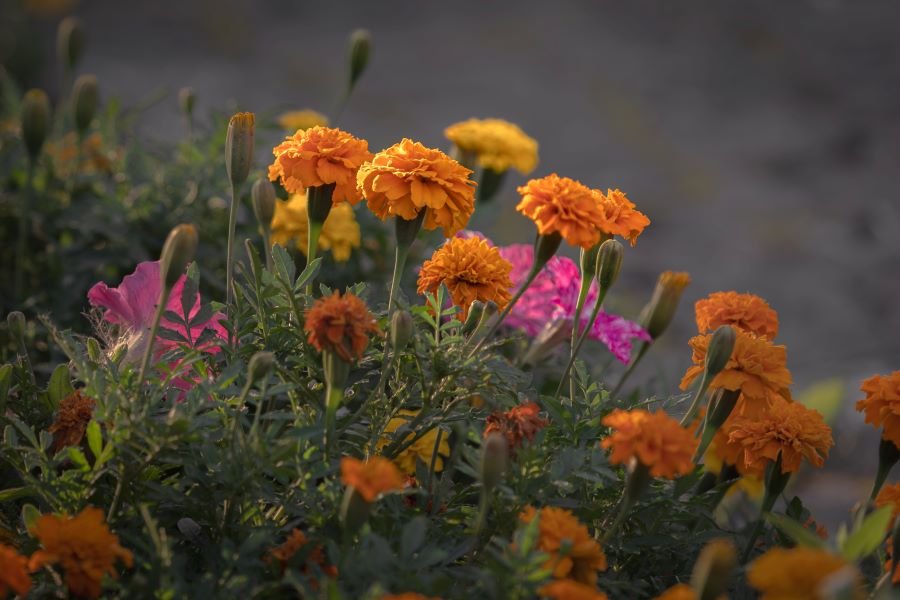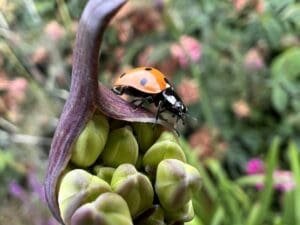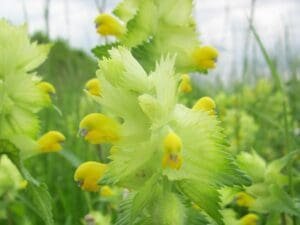Marigolds are one of the most popular annual flowers for gardens. With their bright, cheerful blooms in shades of yellow, orange, and red, it’s no wonder these pretty flowers have been beloved garden classics for centuries.
Growing marigolds is easy and rewarding. These tough, low-maintenance plants bloom freely all season long, requiring little care while adding pops of colour to beds, borders, and containers.
You might also be interested in: Annual Plants for Wild Gardens
Introduction to Marigolds
Marigolds, or Tagetes species, are native to Mexico and Central America. But these ubiquitous flowers have journeyed far from their ancestral home.
Today, marigolds brighten gardens across diverse lands and climates, from India to Iran to the USA. That’s a testament to their adaptability and durability as easy, rewarding garden annuals.
Here are a few reasons to grow marigolds:
- Long bloom season. Marigolds flower freely from late spring until the first fall frost, especially if promptly deadheaded.
- Wide colour range. Choose from yellow, gold, orange, red, maroon, cream, and multi-coloured blooms.
- Pest and deer resistance. Marigolds contain natural compounds that fend off certain garden pests. Deer also tend to avoid them.
- Culinary and medicinal uses. Some varieties have edible flowers and leaves used in teas, salads, and Mediterranean cuisine. The flowers also have antioxidant and anti-inflammatory properties.
- Low maintenance. Marigolds thrive with minimal care and withstand heat, drought, humidity, and poor soil quality.
Planting Marigolds
When to Plant Marigolds
Marigolds can endure cool conditions, so they may be planted up to 2 weeks before your region’s average last frost date.
Most gardeners sow seeds or transplant seedlings outdoors in late spring after any chance of frost has passed.
If starting marigolds indoors, time your planting so the seedlings will be ready to transplant outside approximately 6-8 weeks later.
Starting Marigold Seeds
Starting from seeds gives you more variety options than buying plants – plus it’s economical too.
Here are some tips for sowing marigold seeds:
- Choose a sterilized seed starting mix and containers with drainage holes
- Sow at proper depth according to seed packet directions (usually 1⁄4 inch)
- Maintain warm soil temperature around 70°F
- Water regularly, taking care not to overwater
- Prepare to transplant outdoors after 6-8 weeks when air temps are stable above 50°F
As marigold seedlings grow, provide plenty of bright light and gentle air circulation to prevent damping off disease. Harden off plants for 7-10 days before transplanting outside.
Planting Store-Bought Seedlings
Look for stocky, vibrant marigold seedlings at garden centres displaying:
- Healthy green foliage
- No signs of pests, diseases, or damage
- Good root establishment
Gently remove plants from containers, taking care not to disturb roots. Plant marigolds at the same level they grew in the pots.
Space plants 8-12 inches apart in sunny beds or borders with well-drained soil. Water thoroughly after transplanting.
Marigolds: Care and Maintenance
Marigolds don’t ask for much once established, but providing optimal care ensures the best floral display.
Sun and Soil Requirements
- Sun: Marigolds bask happily in full sun. Give them at least 6-8 good sunlight hours per day. Part shade can work too, but may reduce blooms.
- Soil: These unfussy plants adapt readily to average garden soils. But they thrive in fertile, well-drained loam enriched with compost or manure.
- Water: New plantings need consistent moisture. Established marigolds tolerate dry spells once their roots grow deep, but bloom best with regular water.
- Fertilizer: Apply a balanced liquid flower fertilizer every 3-4 weeks during the growing season for vibrant blooms.
Deadheading Marigolds
Prompt deadheading spent blooms keeps marigolds flowering nonstop into fall. Simply pinch or snip off faded flowers as they wilt.
To encourage a final burst of blooms before frost, stop deadheading marigolds in early fall so the plants can focus energy on seed production.
Preventing Pests and Diseases
These rugged flowers have few difficulties, though they can fall victim to some common garden foes. Learn how to prevent problems and deal with any issues that arise.
Dealing With Pests
- Aphids may colonize leaves and buds, causing curled foliage and stunted blooms. Knock off visible insects with a strong spray of water. Repeat applications to keep colonies away. Or try natural remedies like neem oil or insecticidal soap.
- Spider mites are tiny red or black pests that suck plant fluids. Look for webbing and speckled yellowing leaves. Wipe away webs then spray infested plants with a forceful water stream. Apply multiple applications until mites disappear.
- Caterpillars can be destructive leaf eaters. Scout regularly and hand pick any you see. Use Bacillus thuringiensis treatments if infestations persist. Avoid broad spectrum insecticides which also kill pollinators and other beneficial bugs that help control caterpillars.
- Slugs and snails may chew large ragged holes in marigold foliage overnight. Hand pick slimy pests or trap them in small containers of beer buried up to the rim. Diatomaceous earth sprinkled around plants also deters mollusks. Reapply after watering or heavy dews.
Preventing Diseases
Though generally robust, marigolds aren’t immune to plant diseases. Issues may arise from wet conditions, crowded foliage, or poor site selection. Strategies like these help avoid problems:
- Allow good airflow with proper spacing
- Avoid overhead watering
- Prevent pests that may spread infections
- Disinfect tools to limit transmission
- Remove diseased portions promptly to contain spread
Common marigold diseases include:
- Botrytis blight causes lesions and grey fungal growth on flowers, buds, and stems during damp weather. Unfortunately it stays in overwintered plant debris so rotation is important. Apply fungicides before issues start as preventative measures to keep this aggressive disease away.
- Alternaria leaf spot first shows small brown circles on leaves which gradually enlarge. Eventually it causes yellowing and leaf drop. Apply broad spectrum fungicides weekly at initial infection to avoid proliferation.
- Bacterial leaf spot occurs as translucent spots and lesions surrounded by yellowed halos. Prevent by sterilizing sheers between plants and watering at soil level. Remove infected foliage and destroy (don’t compost). Fungicides are ineffective because bacteria cause this disease.
Choosing Marigold Varieties
With dozens of marigold species and varieties, selecting the right ones for your garden is an important first step.
Let’s explore some top options that perform well across diverse growing zones and conditions.
African Marigolds
These large, bold marigolds (Tagetes erecta) produce huge flowers up to 5 inches across. They include some of the most familiar marigold varieties.
Best for: Beds, borders, cutting gardens
Height: 12-24 inches tall
Blooms: Large, double globes in bright yellow and orange
Popular varieties:
- ‘Crackerjack Mix’ – huge yellow or orange blooms on tall, sturdy plants
- ‘Inca II’ series – free-flowering and drought-tolerant
- ‘Antigua’ series – early to bloom, with 4-5” double flowers
French Marigolds
These compact marigolds (Tagetes patula) have an adorably playful look with their smaller single or double flowers.
Best for: Edging borders or garden beds, containers, window boxes
Height: 6-12 inches
Blooms: 1-2 inches wide, single or double flowers in red, yellow, orange and multi colours
Popular varieties:
- ‘Bonanza Series’ – compact and free-flowering
- ‘Queen Sophia’ – gold-orange bicolour
- ‘Boy Orange’ – bright, bold blooms
Signet Marigolds
Last but not least, signet marigolds (Tagetes tenuifolia) offer tiny single blooms packed with warm spicy scent. They also have fine, lacy foliage.
Best for: Borders, mass plantings, containers, enjoyed up close
Height: 8-12 inches
Blooms: Edible flowers with citrusy flavour
Popular varieties:
- ‘Lemon Gem’ – bright lemon-yellow
- ‘Tangerine Gem’ – zesty orange blooms
- ‘Red Gem’ – deepest red signet flowers
Frequently Asked Marigold Growing Questions
Still have questions about successfully raising marigolds? Here are answers to some common queries:
Q. Are marigolds perennials or annuals?
Most garden marigolds are tender annuals though they may overwinter in very warm zones like 9 and up. There are also a few perennial Tagetes species native to Southwestern US deserts.
Q. Should marigolds be deadheaded?
Yes, promptly deadheading spent blooms encourages plants to keep producing flowers until fall frosts end the season. To save seeds at the end of the year, stop deadheading in early fall so marigolds can focus energy on seed production.
Q. How tall and wide do marigolds grow?
Size varies greatly. Dwarf French marigolds may be 6-12 inches tall and wide while giant yellow/orange African marigolds can tower from 18-30 inches with a spread over 2 feet wide. Check nursery tags for mature dimensions of each particular variety.
Q. Can you plant marigolds from grocery store flowers?
It’s best not to plant store-bought florist marigolds. They may be treated with chemicals or lack the genetics preferred for ideal garden performance compared to plants from reputable seed sources.
Q. How do you harvest marigold seeds?
At the end of the season after flowers fade, stop deadheading so seed pods can form. Allow pods to dry fully on plants, then collect and separate seeds from capsule debris. Let seeds further dry for 1-2 weeks in breathable containers before storing.
We hope these tips help you successfully grow marigolds! Please let us know if you have any other questions.
Conclusion
As you can see, marigolds bring dynamic beauty to gardens and so much more with their edible and aromatic qualities. These iconic flowers definitely deserve their eminent reputation.
Growing marigolds is easily one of the most satisfying garden endeavours. Even novice gardeners delight at their bold colours and carefree performance.
If you’ve never grown marigolds before, their ease and rewards make them well worth trying this season. And if you’re already familiar with their glowing charms, consider adding new colours or varieties to your garden for even more enjoyment.






